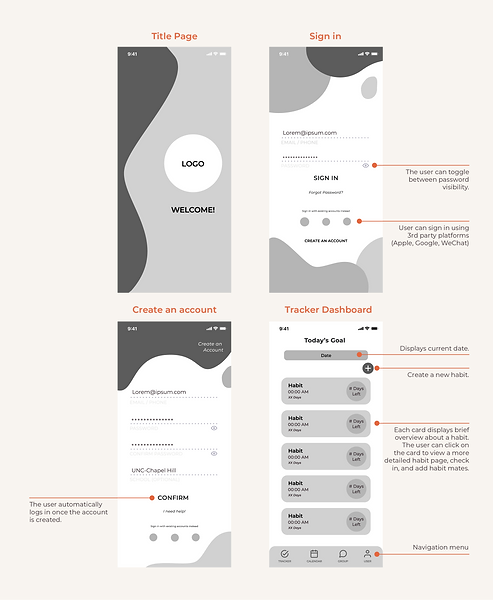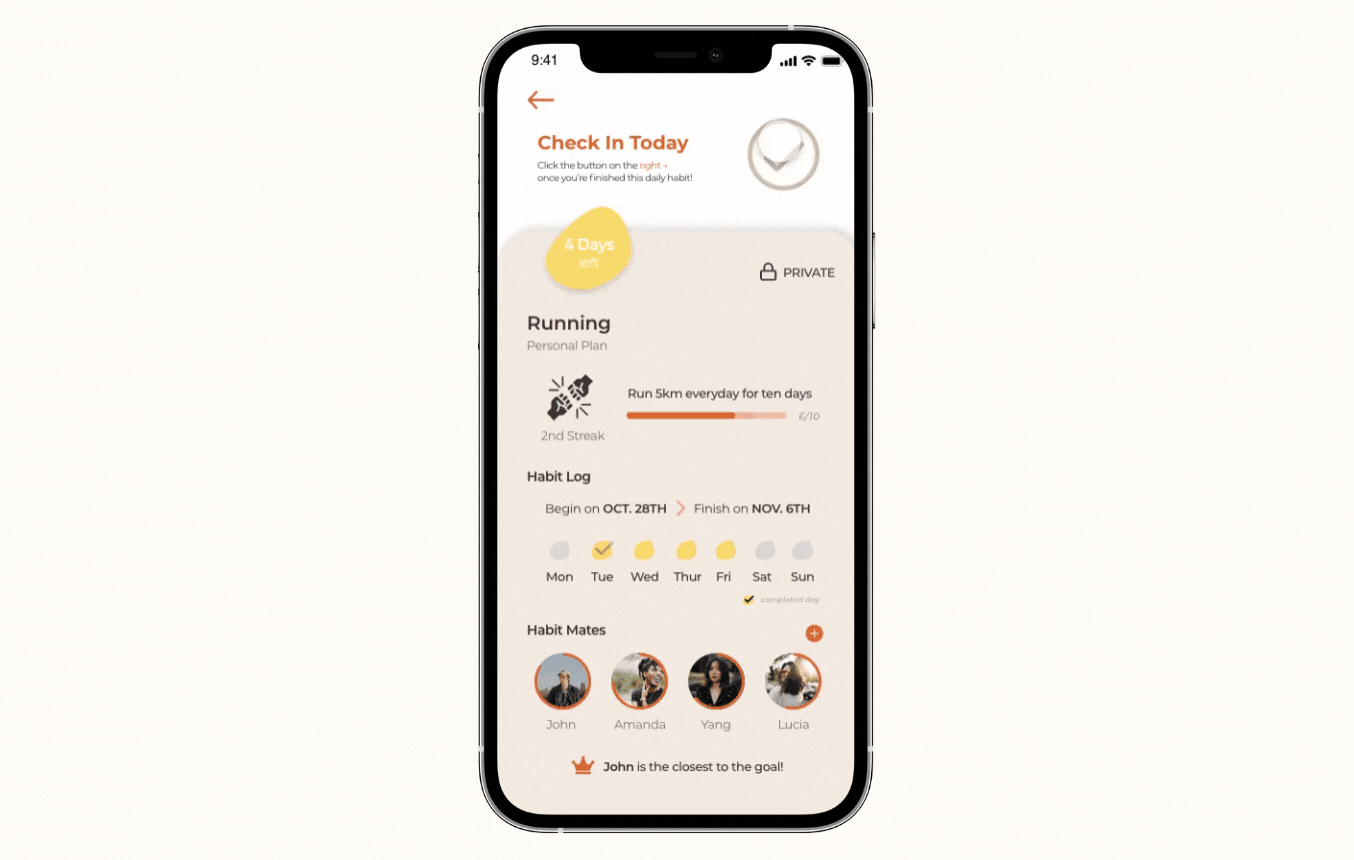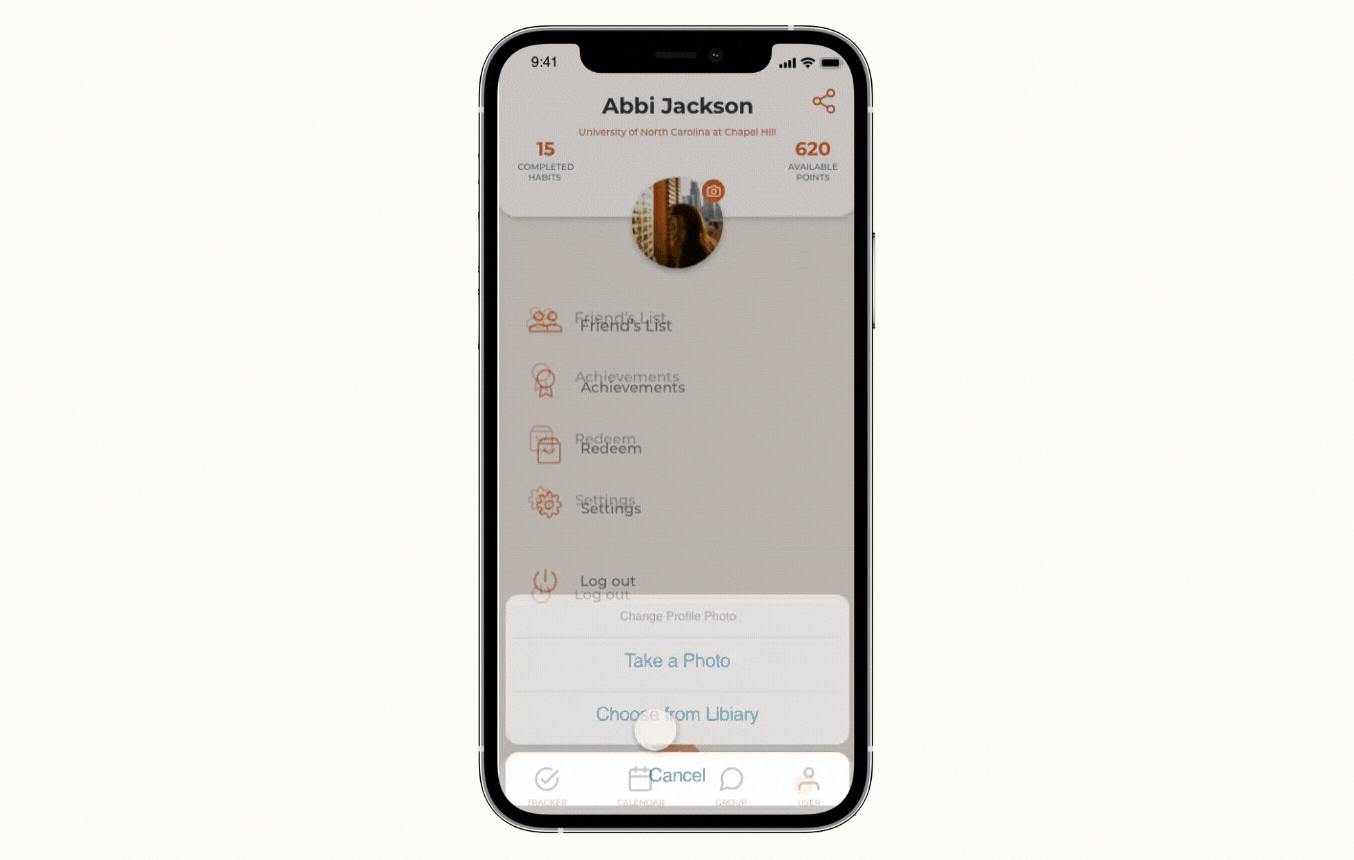Motivation
A Mobile Habit Tracker App

Illustration of final prototype
Overview
Name: Motivation Habit Tracker Mobile Application
Role: Project Co-Lead, UX&UI Designer, Presenter
Software: Adobe XD, Adobe Creative Suite, Usertesting.com
Year: 2020 Nov - Present
Motivation is originally a class project done in a user experience design class. I did it with another same-year classmate. The idea was born during the COVID quarantine period when many people feel unmotivated to work and study from home. We aim to design an app that serves as an external incentive and as a platform to find habit mates.
1.1|Introduction

Illustration by Wind Up
According to the Student Experience in the Research University (SERU) Consortium survey conducted in July 2020, 96% of the 22,519 undergraduate students and 88% of the 7,690 graduate and professional students surveyed at five public research universities said they had faced at least one obstacle during their transition to online learning format. As found in the survey, the top obstacles are the lack of motivation, lack of interpersonal interaction or communication; the inability to learn effectively in remote format, and the lack of proper study environments. The lack of motivation is the largest obstacle of all, faced by 76% of undergraduate students and 56% of graduate students who took the survey (SERU COVID-19 Survey).
1.2|Goals
Despite the growing obstacles, students need to resume their normal academic and personal routines as soon as possible. In this case, motivation tools such as habit trackers and products that help individuals stay focus are effective tools that students can utilize to stay motivated. The purpose and the goal of Motivation are to:
-
Serve as an incentive and supervising tool to help students cultivate habits
-
Foster interactions between peers and friends
-
Help individuals stay focus, and motivate students

1.3|Funtionality
Motivation is organized into four main sections: tracker, calendar, chat, and user center.
The tracker is a dashboard that allows the user to access a list of current habits.
The calendar provides a monthly overview of user activity in the app.
The chat function is where the user can communicate with other users and their habit mates.
A. Tracker 👣
B. Calendar 📅
C. Chat 💬
D. User Center 👥
The user can access the friends' list, achievements page, the in-app store, and settings in the user center.
1.4|Niche Offering




There are many habit trackers, focus boosters, and communication tools out there that students can utilize to boost their study efficiency and maintain their daily routines. Forest is a popular app that allows users to stay focused by eliminating phone distractions. GroupMe and Slack are just some of the common communication tools that students use to communicate with their friends and peers. Momentum and Habitica are two popular habit trackers that help users keep track of their daily habits and routines. However, there is no single tool that would allow users to track their habits, communicate with others, and stay focused all in one app. Moreover, those apps are not designed specifically for students and may not provide the necessary tools that students would need to study effectively or to match a student’s lifestyle. In contrast, Motivation tries to mimic a healthy studying environment as much as possible while also focusing on the importance of peer motivation and effective studying techniques such as Pomodoro study sessions. Motivation allows users to cultivate good habits, create interpersonal communications, and stay focused while also encouraging users to stay motivated, making the product unique out of the number of motivational, communication, and studying apps available for students.
1.5|Measurement of Success
There are three ways to measure the product’s success: (1) number of downloads and ratings in app stores; (2) the number and quality of businesses willing to invest in partnership to provide coupons and other merchandise for users; and (3) user retention rates.
The number of downloads from app stores and the app ratings are good product popularity measurements and success. The more application downloads there are mean that the app has greater popularity. On the other hand, the higher the product rating is in app stores, the more users are satisfied with the product.
The number and quality of businesses that are willing to offer promotions are another way to measure success. Businesses, especially small and local merchants around college campuses and those whose main consumers are students, are more likely to collaborate with applications and platforms that focus on students. It is a cost-efficient way for those businesses to advertise their products and services. The more businesses that are willing to offer partnership shows that the product is a beneficial investment and has a higher potential to be successful.
Measuring user retention rates is also another important standard for success. The user retention rate is the percentage of users who still use an app a certain number of days after installment. A higher retention rate means that users are more likely to keep using the application for long periods of time. Other than the user retention rate, statistics such as how many users are creating new habits, checking in on habits, and starting focus sessions are also effective methods of measuring product success.
2.1|Overview of Audience Analysis
The target audience is determined from a comprehensive analysis of observations made on social media, responses to a short survey that was handed out to approximately 150 students, and statistics from credible sources. Motivation aims to help college students who are studying remotely during the COVID-19 pandemic and even further. According to the National Center for Education Statistics (NCES), there were 16.6 million undergraduate students and 3 million graduate students enrolled at a higher education institution. This number is expected to grow which the total undergraduate enrollment is projected to increase by 2% (0.4 million students) between 2018 and 2029. The survey results and statistics from NCES show that most students enrolled at a higher education institution are between the age of 18-25 (NCES). The education and age statistics indicate that Motivation has a large and young potential audience group.
Other than general statistics regarding the college population, information about how college students are performing during the COVID-19 pandemic is also analyzed. According to the Student Experience in the Research University (SERU) survey completed by approximately 30,000 students at multiple universities in July 2020, a significant number of college students said they faced some kind of obstacles when transiting to remote learning in which lack of motivation is the largest obstacles faced by the majority of survey respondents (SERU COVID-19 Survey).
Motivation has the potential to expand its target audience to a wider age group and more geographic locations. Young individuals in the workforce or students in non-American universities are also potential audiences. More detailed information about the target audience is recorded in the audience analysis chart.
2.2|Audience Analysis Chart
2.3|Personas




3.1|Flow Chart

3.2|Asset List

3.3|Style Guide

4.1|Wireframe






4.2|Interactive Prototype
4.2.1 Tracker 👣
Habits that are due on a certain day are colored, while habits that are not active on that day are temporarily shown in a grey color. Besides a dashboard that displays current habits, the tracker also allows the user to check-in to an active habit and create new habits. To tell the system that a habit has been completed, the user would need to check-in every time after he or she finished a habit. The system will accumulate the number of days a user has completed a habit, and once a habit is completed, the habit is removed from the tracker dashboard. If the user failed to check-in on a day, the habit streak would be broken, and the user will have to start over again. The tracker also allows the user to create new habits. The user will need to complete a short form indicating the habit goal, the habit's duration, and when the habit will be completed every day. Once the user completes the creation process, the new habit will be added to the dashboard.

4.2.2 Calendar 📅
On the calendar, the user can check his or her overall habit completeness for a certain day. If all habits are completed on a certain day, there will be a checked mark underneath that date. Vice versa, if the user did not complete all habits that were due on a day, there will be no indication of completeness. The user can select a day on the calendar to see what habits are missing on a day. If the user wishes to make up for a missing habit, they can use the free buffer to fill in the missing day. The buffer is a free pass that the user can only use the first time they missed a habit task. Once the buffer has been used, the user will have to maintain the habit streak themselves.

4.2.3 Chat 💬
The user can create or join group chats with other users who are completing similar habits, have similar interests, or are completing some tasks together either academically or personally (e.g., classes and student organization). Users can also start a group focus session designed to help individuals stay focused on certain tasks. The goal of the focus session is to mimic study rooms at universities where students usually study with friends and peers. Students can study virtually for a set time with friends, peers, or other users with focus sessions. Any group chat member can start focus sessions, and other members can join the session freely. In a focus session, members can freely communicate with each other via voice or video call. However, users can also mute or disable voice and video to avoid unnecessary distractions.

4.2.4 User Center 👥
The friends' list contains all other users whom the user has befriended in Motivation. The achievement page and the in-app store constitute the reward system in the app. The purpose is to gamify the application, so users will have the incentive to complete more tasks and utilize the app more effectively. The user can collect badges by completing achievements and collecting points to exchange for prizes such as avatar frames and store coupons. Lastly, the user can change his or her personal information and app preferences in the settings.

5.1|Usability Testing
5.1.1 Testing Setup ⏳
You are a college student studying remotely at home. You downloaded this app to help you keep track of your homework and personal habits as well as keep in touch with your friends and peers. Imagine the following scenarios and complete the tasks.
-
You have completed your running task for today. Please check in to tell the app that you are finished with the task.
-
Navigate to the Calendar and use the buffer on your “Running” task that you missed on November 2nd. Explain what is the buffer function.
-
You realized you just finished another habit and you can earn a new level of “Five for it” badge. Go to your user page and collect your points from the “Achievements” and redeem your points at the shop.
-
Your final exams are coming up and you want to make sure you are preparing for the upcoming math exam by doing problems every day. Add this task to your habit tracker.
-
When you finished your math practice exam, you find some problems confusing. You want to discuss them with your peers from your MATH341 group chat, but it was difficult to communicate in the chat. Start a focus session in the group chat.
-
You want to invite all of your peers from your MATH341 group chat to be your running buddies. On the “Running” detail page, add all of them as your new habit mates.
5.1.2 Positive Findings ✅
-
Most participants were able to complete all of the task scenarios without any problems. Most participants answered that they did not doubt that they had completed the task on the post-task question.
-
Many participants said they liked the product design. One participant mentioned that she had never seen a product that has similar designs.
-
A participant said she thinks the product is a fantastic idea and that it can also be useful for the user groups beyond the student body.
-
A participant said she would recommend the product to others, and she thought the app is better than other similar apps that she had seen in the market.
-
A task scenario involved the participants explaining what the buffer function is. All of the participants were able to explain clearly what the buffer function is.
-
Participants said the app is easy to navigate.
-
Participants thought the tutorial was helpful.
-
A participant said she liked the reward system and thought it is a good incentive.
5.1.3 Negative Findings 💢
-
Participants had trouble using the wheel to change the duration of the habit on the “Create a New Habit” page. Although the functionality was set to drag, many participants attempted to tap on the interaction.
-
During the first two usability tests, there were bugs in the prototype interaction. The participants were unable to use some of the functionalities and thus, did not complete some tasks.
-
Participants mentioned that some of the texts were hard to read because of the lack of color contrasts.
-
One of the participants thought the buffer function was unnecessary and that it should be replaced by a cheat day system (users can get an entire day off).
-
A participant said he wouldn’t recommend the product to others because the product looks like it is designed for secondary education students (high school and middle school).
5.1.4 REVISIONS BASED ON USABILITY TESTING RESULTS 🛠
-
Some participants mentioned there were bugs in the prototype. The problem was minimized by checking over the interactions several times in the revised version.
-
Participants mentioned some of the pages were confusing due to the lack of context cues. More context cues and tutorial pages were added in the revised version.
-
A participant was confused about the levels (1-2-3-4-5) on the achievement detail page. In the revised prototype, the layout was changed to reflect the hierarchy of the context better.
-
A participant was confused about the voice message icon in the chat interface. The icon was changed.
-
A task scenario involved participants adding new habit mates to an existing task. Participants were uncertain if they completed the task because there was no confirmation page. A participant also mentioned that there was no option to withdraw from the invitation if she accidentally invited the wrong habit mate. A confirmation page was added in the revised version.
-
A participant said the information hierarchy on the habit detail page was confusing. When she was completing the check-in task, she ignored the check-in section on the top. To fix this problem, we changed the section title's font color so the section would stand out more.
* The presented prototype and link for the full prototype in the 4.0 section are already the revised version.
*Testing participants' recordings can be available through DM.
6.0|Learnings & Reflections
-
Motivation is the biggest personal project I have ever done. It has been last for more than a year and the software is still under development now.
-
Through this project, I practiced the UX skills and knowledge I learned from multiple UX courses. Most importantly, I got a chance to conduct extensive user research, collect user data, and analyze users' preferences, which are far beyond the design scope.
-
Special kudos to the best teammate JoJo Yang. This is our second time collaborating. Always 1+1 > 2.
*The project was initiated in INLS382 Information System Analysis class and Design and MEJO581 User Experience Design and Usability class in UNC. Thanks to Professor Laura Ruel and Professor Ryan Urquhart who gave us so much support in creating a project throughout two courses. 😀

.png)



